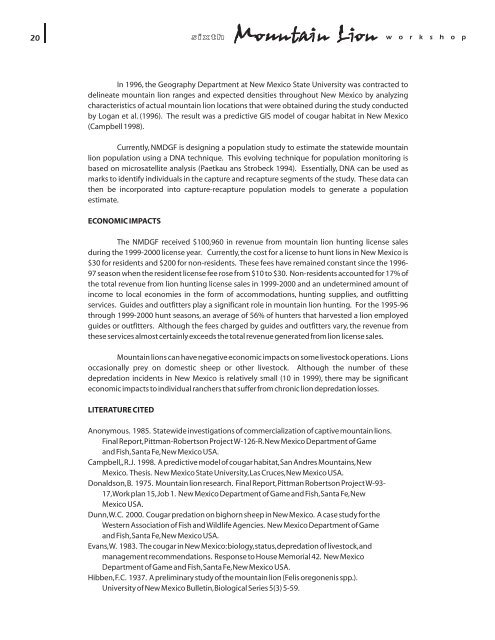PWD BK W7000-893 Proceedings.CDR - Mountain Lion Foundation
PWD BK W7000-893 Proceedings.CDR - Mountain Lion Foundation
PWD BK W7000-893 Proceedings.CDR - Mountain Lion Foundation
You also want an ePaper? Increase the reach of your titles
YUMPU automatically turns print PDFs into web optimized ePapers that Google loves.
20<br />
In 1996, the Geography Department at New Mexico State University was contracted to<br />
delineate mountain lion ranges and expected densities throughout New Mexico by analyzing<br />
characteristics of actual mountain lion locations that were obtained during the study conducted<br />
by Logan et al. (1996). The result was a predictive GIS model of cougar habitat in New Mexico<br />
(Campbell 1998).<br />
Currently, NMDGF is designing a population study to estimate the statewide mountain<br />
lion population using a DNA technique. This evolving technique for population monitoring is<br />
based on microsatellite analysis (Paetkau ans Strobeck 1994). Essentially, DNA can be used as<br />
marks to identify individuals in the capture and recapture segments of the study. These data can<br />
then be incorporated into capture-recapture population models to generate a population<br />
estimate.<br />
ECONOMIC IMPACTS<br />
The NMDGF received $100,960 in revenue from mountain lion hunting license sales<br />
during the 1999-2000 license year. Currently, the cost for a license to hunt lions in New Mexico is<br />
$30 for residents and $200 for non-residents. These fees have remained constant since the 1996-<br />
97 season when the resident license fee rose from $10 to $30. Non-residents accounted for 17% of<br />
the total revenue from lion hunting license sales in 1999-2000 and an undetermined amount of<br />
income to local economies in the form of accommodations, hunting supplies, and outfitting<br />
services. Guides and outfitters play a significant role in mountain lion hunting. For the 1995-96<br />
through 1999-2000 hunt seasons, an average of 56% of hunters that harvested a lion employed<br />
guides or outfitters. Although the fees charged by guides and outfitters vary, the revenue from<br />
these services almost certainly exceeds the total revenue generated from lion license sales.<br />
<strong>Mountain</strong> lions can have negative economic impacts on some livestock operations. <strong>Lion</strong>s<br />
occasionally prey on domestic sheep or other livestock. Although the number of these<br />
depredation incidents in New Mexico is relatively small (10 in 1999), there may be significant<br />
economic impacts to individual ranchers that suffer from chronic lion depredation losses.<br />
LITERATURE CITED<br />
sixth <strong>Mountain</strong> <strong>Lion</strong> w o r k s h o p<br />
Anonymous. 1985. Statewide investigations of commercialization of captive mountain lions.<br />
Final Report,Pittman-Robertson ProjectW-126-R.New Mexico Department of Game<br />
and Fish,Santa Fe,New Mexico USA.<br />
Campbell,,R.J. 1998. A predictive model of cougar habitat,San Andres <strong>Mountain</strong>s,New<br />
Mexico. Thesis. New Mexico State University,Las Cruces,New Mexico USA.<br />
Donaldson,B. 1975. <strong>Mountain</strong> lion research. Final Report,Pittman Robertson ProjectW-93-<br />
17,Work plan 15,Job 1. New Mexico Department of Game and Fish,Santa Fe,New<br />
Mexico USA.<br />
Dunn,W.C. 2000. Cougar predation on bighorn sheep in New Mexico. A case study for the<br />
Western Association of Fish andWildlife Agencies. New Mexico Department of Game<br />
and Fish,Santa Fe,New Mexico USA.<br />
Evans,W. 1983. The cougar in New Mexico:biology,status,depredation of livestock,and<br />
management recommendations. Response to House Memorial 42. New Mexico<br />
Department of Game and Fish,Santa Fe,New Mexico USA.<br />
Hibben,F.C. 1937. A preliminary study of the mountain lion (Felis oregonenis spp.).<br />
University of New Mexico Bulletin,Biological Series 5(3) 5-59.
















